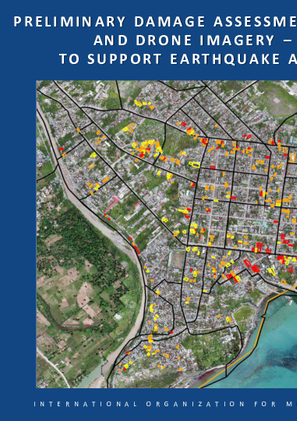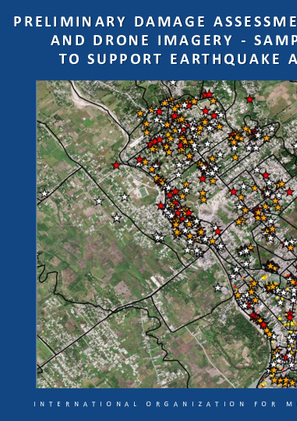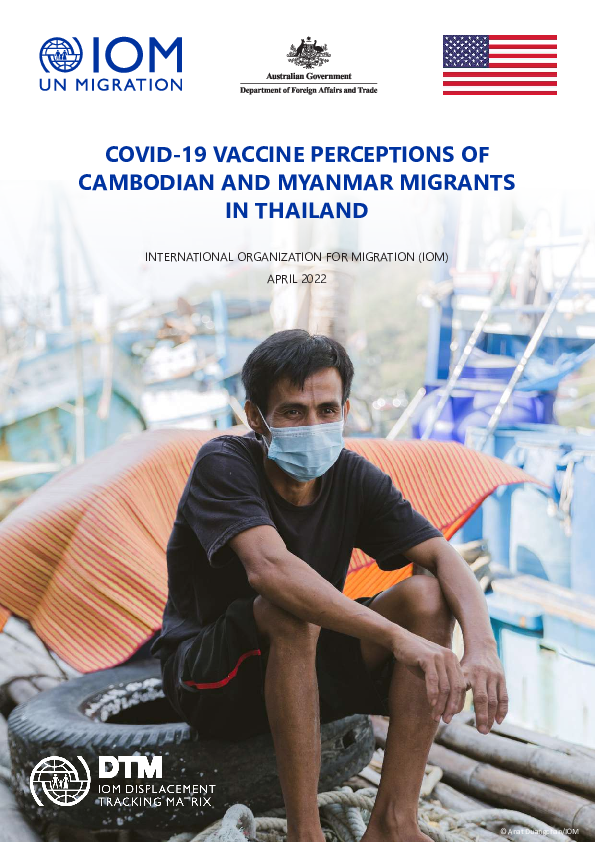-
Countries
-
Data and Analysis
-
Special Focus
-
Crisis Responses

Contact
DTM Mali, DTMMali@iom.int
Language
French
Location
Mali
Period Covered
Mar 01 2022
Mar 31 2022
Activity
- Flow Monitoring Survey
- Flow Monitoring
Afin de mieux comprendre les mouvements et tendances migratoires, l’OIM, à travers la Matrice de suivi des déplacements (Displacement Tracking Matrix, DTM), met en œuvre l’activité de Suivi des flux de populations (Flow Monitoring, FM).
Le suivi des flux, qui est mis en œuvre en étroite collaboration avec les autorités et des partenaires nationaux et locaux, est composé de deux outils: l’enregistrement des flux (Flow Monitoring Registry, FMR), qui recueille des données clés sur l’ampleur, la provenance, la destination et les modalités des flux de mobilité, et les enquêtes individuelles (Flow Monitoring Survey, FMS), conduites auprès des voyageurs afin d’obtenir des informations sur les profils, parcours migratoires, et intentions des migrants. Le suivi des flux de populations récolte ainsi des données sur les flux et tendances migratoires, les profils des voyageurs et les parcours et intentions des migrants, afin de fournir une meilleure compréhension des mobilités.
Au Mali, la DTM recueille des données au niveau de 7 Points de suivi des flux (Flow Monitoring Points, FMP), répartis dans 6 régions afin d’obtenir une meilleure compréhension de l’ampleur, des tendances, des caractéristiques socio-démographiques et des parcours des flux de voyageurs traversant ces différents points.
Ce rapport présente les données recueillies dans le cadre des activités d’enregistrement des flux durant le mois de mars 2022.

Contact
DTMcovid19@iom.int
Language
English
Location
Global
Snapshot Date
Apr 18 2022
Activity
- Other
The DTM Global Mobility Restrictions Overview provides updates on international air travel restrictions and conditions for
authorized entry. This overview aims to understand how COVID-19 has impacted human mobility, detailing how global
and regional trends in air travel measures have evolved since COVID-19 was declared a global pandemic in March 2020.
The data presented focuses on the changes in public health-related immigration and border management measures. It
provides information intended to support IOM missions and partners in targeted response planning and advocacy for
vulnerable populations who may be affected by changes in global mobility.

Contact
dtmhaiti@iom.int
Language
English
Location
Haiti
Period Covered
Sep 19 2021
Dec 31 2021
Activity
- Survey
In 2021, the International Organization for Migration (IOM) in Haiti provided reception and post-arrival assistance to 19,629 adult and child migrants repatriated to Haiti by both air and sea to Port-au-Prince and Cap-Haïtien. The vast majority - 76 per cent - were returned by flight from the United States, while smaller proportions were returned by other countries and territories in the region, mainly the Bahamas, Cuba, Mexico and the Turks and Caicos Islands. A small number of migrants were returned after being intercepted at sea by the Coast Guard. Most returns by air and sea that took place in 2021 - 84 per cent - occurred between the months of September through December 2021, with the largest waves arriving from 19 September onward.

Contact
dtmhaiti@iom.int
Language
English
Location
Haiti
Period Covered
Oct 12 2022
Feb 14 2022
Activity
- Registration
Since the beginning of 2021 and through 14 February 2022, the International Organization for Migration (IOM) in Haiti provided
reception and post-arrival assistance to 24,671 adult and child migrants repatriated to Haiti by both air and sea. The vast majority
returned in this period - 76 per cent - were returned by flight from the United States, while smaller proportions were returned by
other countries and territories in the region, mainly the Bahamas, Cuba, Mexico and the Turks and Caicos Islands. A small number of migrants were returned after being intercepted at sea by the Coast Guard. Most returns by air and sea that took place in this period - 87 per cent - occurred from September 2021 onward.

Contact
dtmhaiti@iom.int
Language
English
Location
Haiti
Snapshot Date
Aug 14 2021
Activity
- Other
Les Cayes is analyzed through photo interpretation to catch all damaged and destroyed buildings. Manually, buildings can be
missed, and procedure is taking time to evaluate. Harder to check on satellite imagery because many buildings seems not
having damages. The use of drone images can validate the type of damage on satellite imagery.

Contact
dtmhaiti@iom.int
Language
English
Location
Haiti
Snapshot Date
Aug 14 2021
Activity
- Other
In Les Cayes centre ville where WB drone imagery overlaps with the satellite imagery from DigitalGlobe , the Copernicus
EMS photo interpretation analysis revealed 66 buildings:
- 2 destroyed (red)
- 21 damaged (orange)
- 43 possibly damaged (white)
Contact
Location
Thailand
Activity
- Survey
- Flow Monitoring
Period Covered
Nov 11 2021 -Feb 13 2022
From mid-November 2021 to mid-February 2022, a total of 4,429 surveys were collected among Cambodian and Myanmar migrants in the provinces of Chanthaburi, Chonburi, Ranong, Rayong, Tak, Trat, and Greater Bangkok Area. The findings help to identify attitudes and perceptions on COVID-19 vaccination, gauge the prevalence of vaccine acceptance among migrant communities in Thailand, and better understand the reasons for vaccine hesitancy. Additionally, the findings can be used to predict the trends about future vaccine uptake among these migrant communities and, consequently, develop strategies to improve acceptability and inform policy and possible responses to flatten the COVID-19 infection curve.
Population Groups
Survey Methodology
Unit of Analysis Or Observation
Type of Survey or Assessment
Keywords
Geographical Scope
Administrative boundaries with available data
The current dataset covers the following administrative boundaries

Contact
DTM Thailand, dtmthailand@iom.int
Language
English
Location
Thailand
Period Covered
Nov 11 2021
Feb 13 2022
Activity
- Survey
- Community Perception
From mid-November 2021 to mid-February 2022, a total of 4,429 surveys were collected among Cambodian and Myanmar migrants in the provinces of Chanthaburi, Chonburi, Ranong, Rayong, Tak, Trat, and Greater Bangkok Area. The findings help to identify attitudes and perceptions on COVID-19 vaccination, gauge the prevalence of vaccine acceptance among migrant communities in Thailand, and better understand the reasons for vaccine hesitancy. Additionally, the findings can be used to predict the trends about future vaccine uptake among these migrant communities and, consequently, develop strategies to improve acceptability and inform policy and possible responses to flatten the COVID-19 infection curve.

Contact
DTMMozambique@iom.int
Language
English
Location
Mozambique
Period Covered
Apr 13 2022
Apr 19 2022
Activity
- Event Tracking
- Mobility Tracking
During the reporting period (13 to 19 April 2022), a total of 41 movements were recorded - 8 returns (3,851 individuals), 28 arrivals (776 individuals), and 3 departures (20 individuals). The largest return movements were recorded in Muidumbe (3,827 individuals) and Palma (20 individuals). The largest arrival movements were recorded in Nangade (450 individuals) and Macomia (208 individuals). The largest departure was observed in Ibo (13 individuals). Of the total population, 11 per cent of mobile groups were displaced for the first time, and 89 per cent of reported individuals have been displaced more than once prior to this movement.

Contact
DTM Nigeria, AllUsersInDTMNigeria@iom.int
Language
English
Location
Nigeria
Period Covered
Jan 03 2022
Jan 31 2022
Activity
- Other
In the BAY states of North-east Nigeria (Borno, Adamawa and Yobe), various conflict escalations have been noted in recent times. The security situation remains unpredictable and leads to fluid mobility. Some violent attacks by NSAG (Non-State Armed Groups) were recorded in the last months of 2021 against IDPs, returnees and aid workers. At present, the humanitarian situation is rapidly approaching famine levels and is characterised by high levels of food insecurity, malnutrition and exposure to diseases.
Additionally, recent efforts by the Borno State Government (BSG) to shut down displacement camps in the urban centres of Borno State have created several risks and hardships. Many IDPs who resided in the camps have now integrated in camps and host communities in their LGAs of origin. In most cases, the security situation in areas of origin is still considered unsafe and does not allow for a safe return to their villages. The influx of IDPs in the respective LGAs has resulted in additional pressure on already stretched facilities and services across the camps and host communities.
In order to find durable solutions for internal displacement — whether through return to communities of origin, local integration, or relocation — and to prevent new displacements in the region, it is critical to understand the relative levels of stability in locations hosting returnees or displaced populations. Therefore, IOM has launched the Stability Index (SI) in Nigeria, to evaluate the stability of areas hosting returnees or displaced populations. The SI seeks to understand which factors influence a location's stability, which can inform priority programmatic interventions along the humanitarian, peace and development nexus in order to strengthen the resilience and stability and prevent future forced displacements.
This report presents the result from the second Stability Index round conducted in January 2022 in Nigeria’s BAY states (Borno, Adamawa and Yobe).
